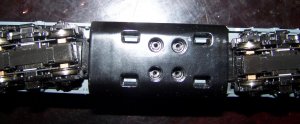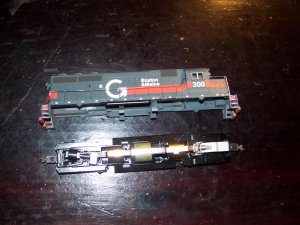Breor47
Brakeman
I don't think there's an easier task than replacing a coupler... unless you're talking about replacing a coupler on the locomotive I have here.
The coupler boxes on this one are formed by both the metal base, as one might call it, and the plastic shell. The two press together and form a little space for each coupler, so I'll need to remove the shell to replace the coupler. Strange; none of my other locomotives work like this.
And removing the cell is proving to be a task by itself. They've (whoever "they" are, the locomotive does not have any manufacturer identification whatsoever on it) got four screws on the bottom and then four plastic clips.

I've removed the screws (thankfully, I can do that) but the clips are difficult. I can tell that you're supposed to bend the tops inward so that they can then slide through the slots, but then the question becomes how to do four at once!
Each one is set inside a trench nearly a centimeter deep, with no room around it. They are set too far apart for tweezers, pliers have prongs that are too think to slip in between the plastic part and the inside of the trench.
If I had five hands, and very long nails, I suppose this would be possible.
Any ideas?
EDIT: I think the locomotive could be this.
The coupler boxes on this one are formed by both the metal base, as one might call it, and the plastic shell. The two press together and form a little space for each coupler, so I'll need to remove the shell to replace the coupler. Strange; none of my other locomotives work like this.
And removing the cell is proving to be a task by itself. They've (whoever "they" are, the locomotive does not have any manufacturer identification whatsoever on it) got four screws on the bottom and then four plastic clips.

I've removed the screws (thankfully, I can do that) but the clips are difficult. I can tell that you're supposed to bend the tops inward so that they can then slide through the slots, but then the question becomes how to do four at once!
Each one is set inside a trench nearly a centimeter deep, with no room around it. They are set too far apart for tweezers, pliers have prongs that are too think to slip in between the plastic part and the inside of the trench.
If I had five hands, and very long nails, I suppose this would be possible.
Any ideas?
EDIT: I think the locomotive could be this.
Last edited by a moderator:


